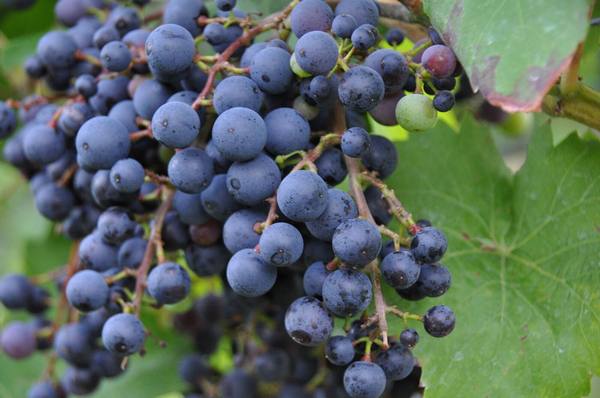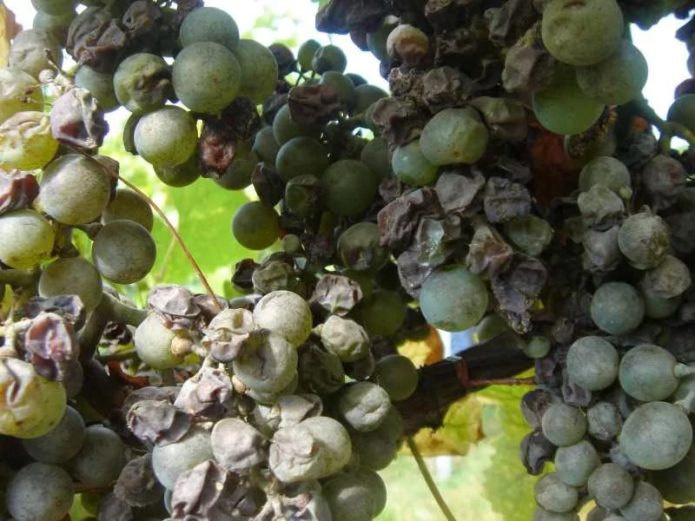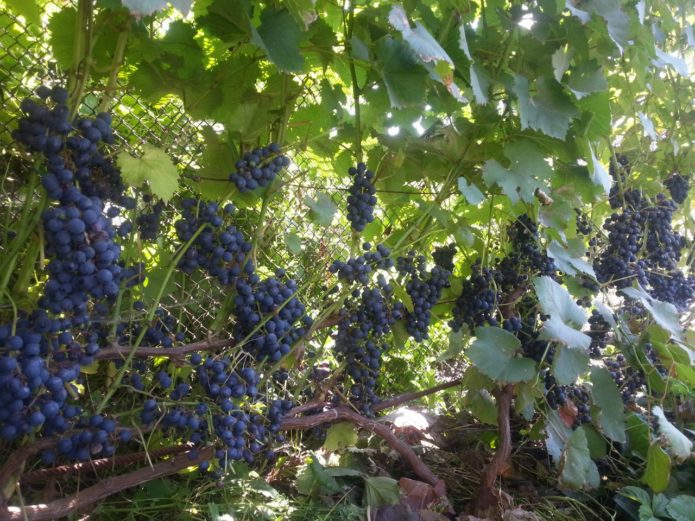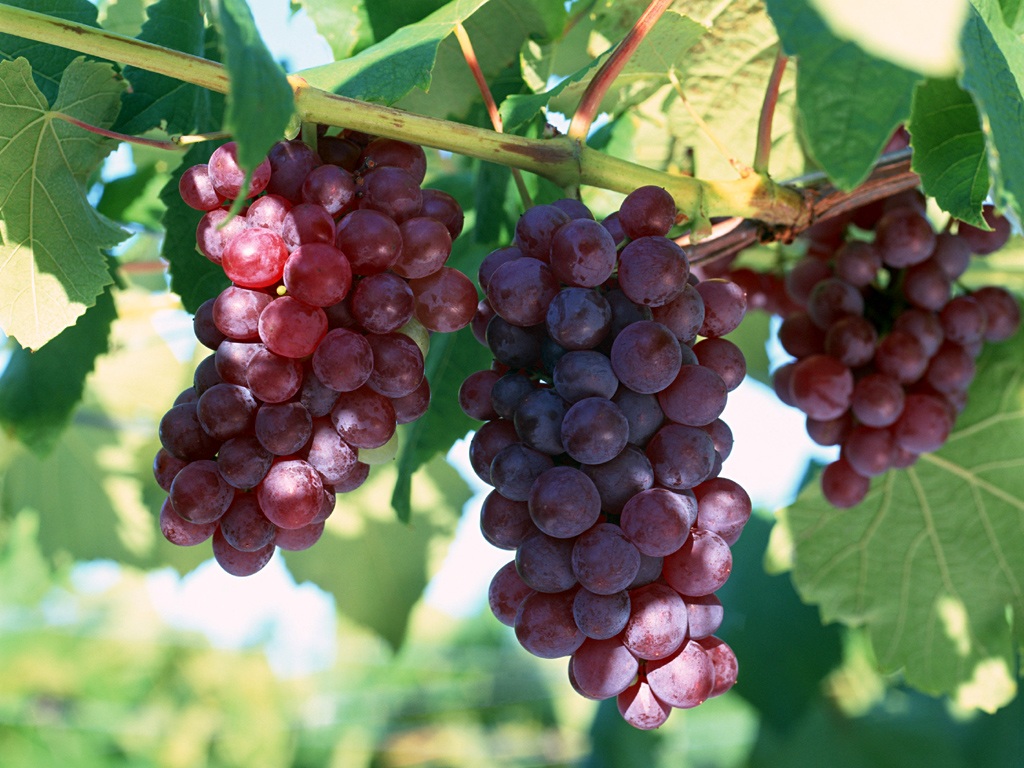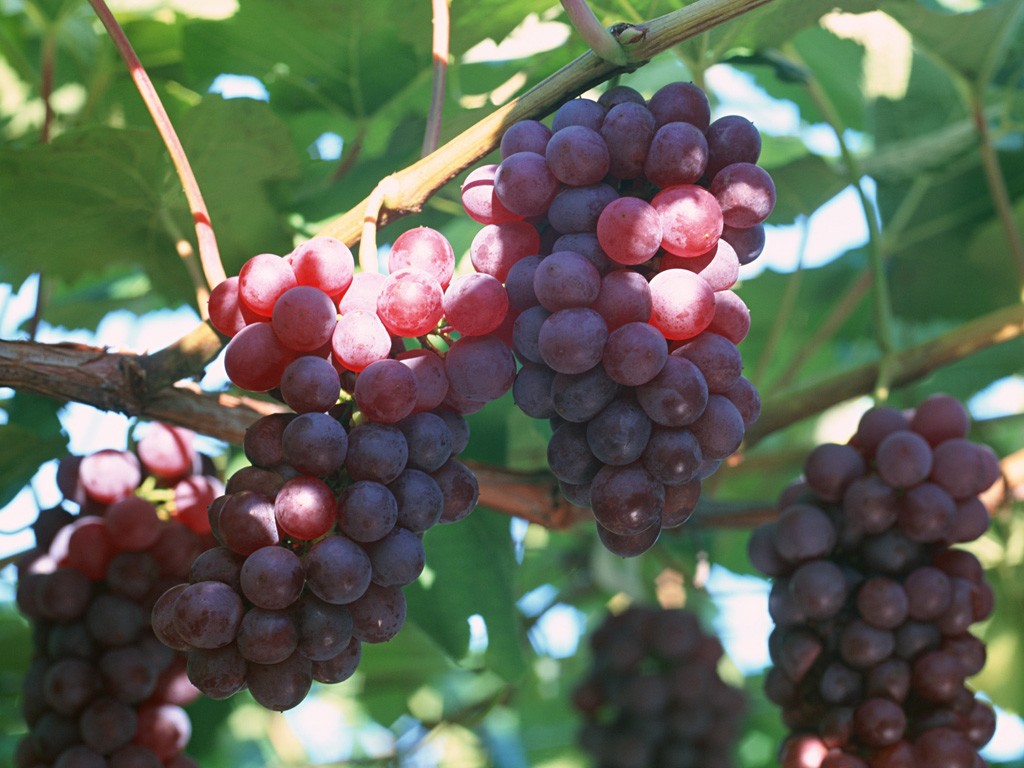The early Violet grape has been known for over 70 years, but even now it has not lost its significance. Its berries are suitable both for direct consumption and for winemaking: a muscat called Steppe rose is prepared on its basis. Since the variety has increased cold resistance, it is grown in many regions with little or no shelter.
Content
Breeding history, description and characteristics of the early purple grape variety
An intensive growth in the number of new grape varieties has been observed in recent decades. In those years when the Violet Early variety was obtained, there were not very many of them, and the appearance of each successful variety was considered a small victory.
Variety history
Violet early grape, which is considered a European-Amur hybrid, was obtained in the Novocherkassk VNIIViV them. Ya. I. Potapenko, who has been breeding new varieties for over 80 years. The parental forms were North and Muscat Hamburg. Early purple was obtained back in 1947, but it took scientists a long time to bring it to optimal characteristics, was intensively tested, and only in 1957 was an application filed for inclusion in the State Register.
For another 8 years, the State tests of the variety went on, and in 1965 the grapes received their place in the State Register of the country. The variety is recommended for growing in warm regions - the Nizhnevolzhsky and North Caucasian regions, but due to its winter hardiness it has spread much further north. True, in the middle lane, its product characteristics are somewhat worse. The climate of Ukraine is also suitable for its cultivation, but already at the latitude of Kiev there are some problems with leaving.
Let's look at the natural and climatic potential of Belarus and find out which grape variety is capable of bearing fruit here:https://flowers.bigbadmole.com/en/yagody/vinograd/vinograd-v-belarusi-sorta.html
Video: early purple berries on bushes in the middle lane
Plant characteristic
Grape Violet early grows in the form of a medium-sized bush, consisting of many shoots, high foliage. Shoots of an adult plant are light brown in color, up to brown. The vine grows quickly, the bush is prone to thickening, requires mandatory formation. Annual shoots ripen satisfactorily. Leaves are moderately dissected, medium-sized, slightly rounded in shape, with slight pubescence on the underside.
For the time of its creation, the variety was one of the most frost-resistant, now this figure is at the level of most modern grape varieties: the vine can withstand frosts down to -27 aboutC. In the recommended growing regions, shelter for the winter is not required; in the middle lane, light shelter is necessary. Disease resistance and resistance to most pests are above average. It is affected by powdery mildew, unstable in relation to phylloxera.
The flowers are bisexual, no pollinators are required. Violet early - a variety of early ripening: from the beginning of budding until the fruits reach ripeness, 130-135 days pass. The purpose of the harvest is universal, but if for the use of berries for food they are removed in early September, then for winemaking - only at the end of the month. Fruitful shoots are about 80%, each fruitful shoot contains one or two clusters. The yield is very high even without irrigation.
Description of berries
The berries are collected in clusters of medium size (15-17 cm long, weighing 150-180 g). The bunches are rather loose, cylindro-conical in shape. The berries, by modern standards, are small, about 15 mm in diameter, weighing 2–3 g, round. The color of the berries corresponds to the name of the variety: it is dark purple, but due to the gray-blue wax bloom it seems blue-violet. The skin is medium density, the number of seeds is 2 or 3. Good-tasting pulp with a characteristic nutmeg aroma. The juice content is high, up to 84%, but the juice, in contrast to the pulp, has practically no color.
The optimal ratio of sugar and acid content makes the berries suitable both for direct consumption and for making high-quality Muscat wines. Grape juice from Violet Early is rated 8.9 points by tasters.
They say that in the taste and aroma you can feel the shades of not only nutmeg, but also rose.
Among the grape varieties that are table and wine, Violet early and now occupies far from the last place.
North Saperavi is one of the best dark-colored technical grape varieties grown for more than half a century. An excellent dessert wine is obtained from Saperavi, as well as several varieties of fortified wines:https://flowers.bigbadmole.com/en/yagody/vinograd/saperavi-sort-vinograda.html
Features of planting and growing grapes Purple early
Features of agricultural technology of grapes are inherent in its properties. So, the undemandingness of the growing conditions facilitates its planting, but the instability to infection with powdery mildew requires extra labor when caring for the plant.
Landing
Choosing a place for planting early purple grapes is easy. It belongs to the small number of varieties that can grow almost everywhere. It can be a flat area or a small slope. The soil can serve as fertile loams and sandy loams, and stony soils, even not too heavy salt marshes suit it. There is even an opinion that for its planting, a landing pit is practically not required in the usual sense of the word: "where you poked, it will grow there." It seems that such recommendations should be taken with skepticism, and if there is a desire to get really high yields of full-fledged berries, it is necessary to plant grapes according to all the rules.
So, for example, Violet early can grow and bear fruit in partial shade, but only in sunny areas do the berries gain as much sugar as is required by the characteristics of the variety. In the middle zone, it must be protected from cold winds; there is no such danger in the south. Moreover, it is desirable that the bush be ventilated, since the danger of infection with powdery mildew, to which Violet Early is prone, in this case is significantly reduced.
Seedlings in containers can be planted at any time, from spring to autumn. Seedlings with bare roots - in spring (April) or autumn (September). Since the bush is not very sprawling, a compacted planting is possible. The optimal distance between the bushes is one and a half meters, but in the conditions of a large area they even use grape planting scheme 1.0 x 1.5 m. It is better to dig a hole, as for most varieties, with dimensions of at least 50 x 50 x 50 cm, this must be done in advance. Drainage is laid at the bottom of the pit (10-15 cm of expanded clay, crushed stone or broken brick), then fertile soil mixed with a bucket of humus, 50-70 g of superphosphate and a half-liter jar of wood ash.
Early purple is grown both in standard form and in bush form. If it is assumed that you will have to cover the grapes for the winter, that is, the winters in the region are relatively cold, it is better to choose a bush form and plant a seedling, deepening it to the first branch on the shoot. The planting technique is the most common: a seedling placed in a hole is covered with fertile soil, compacted, well watered and mulched with humus, peat or straw.
Care
Early purple is able to grow even in non-irrigated areas, but in the first year, until it develops roots, it is necessary to water the seedling frequently, preventing the soil from drying out. Subsequently, in the absence of rain, you should try to water it 1-2 times a month in moderate doses (so that the water does not stagnate on the surface). It is important to water the bushes well before flowering, when the berries reach the size of a pea, and also not to forget about water-charging podzimny watering. When the berries grow to the size characteristic of the variety, watering is stopped.
Top dressing is started 2-3 years after planting. The main fertilization is in the fall, in the grooves dug out on the periphery of the bush. The norm is two buckets of humus and 200-300 g of ash. Liquid top dressing in the form of mullein infusion (1:10 or 1:15) is given after bud break and 1–2 weeks after the end of flowering. Like any other grape variety, Violet Early also welcomes foliar feeding with weak solutions of mineral fertilizers (urea immediately after the leaves open and Azophoska - after flowering).
High-yielding grapes require strong trellis. The shoots of Violet Early are tied up as they grow, while simultaneously carrying out green operations (pinching and pinching), preventing excessive thickening of the crown. The main work on the formation of the bush is carried out in early spring or late autumn by pruning.
Most often, gardeners make vertical single-plane trellises for grape garters. Putting such a support is not particularly difficult:https://flowers.bigbadmole.com/en/yagody/vinograd/kak-podvyazyvat-vinograd-vesnoy.html
In the southern regions, they prefer to grow this grape on a 1.0-1.2 meter high stem, forming a plant in two arms. In the middle lane, it is more convenient to have a stamp-free formation: they organize a bush of four sleeves. The crop has to be rationed, but this is not difficult. It is only important when trimming to leave from 5 to 7 eyes on each sleeve, and you will not have to remove the clusters: Violet early independently forms no more than two pieces on each shoot.
The variety is highly immune to most diseases, but suffers from powdery mildew. This is a terrible disease that can leave the grower without a crop, and if you do not treat diseased bushes, then lead to their death. Therefore, preventive treatments with copper or iron vitriol in early spring, 1% Bordeaux mixture after the appearance of the first leaves and after leaf fall are required. Unfortunately, it is difficult to protect against phylloxera with preventive treatments, therefore, in those areas where there are big problems with this pest, they try to plant phylloxera-resistant grape varieties.
Harvested in dry weather. And if for fresh consumption the berries are ready by the very end of summer (the word "early" in the name is no longer quite true: there are a lot of varieties much earlier ripening), then for a set of sugar content sufficient for winemaking, the berries are left on the bushes for almost for a month. They stick to the branches well, in the absence of excess moisture they do not deteriorate.
Still, we must admit that as a table variety Violet Early has practically lost its significance: the range of varieties for fresh berries is now very wide. Basically, berries are processed: juice is squeezed out of them and wine is made.
Since the juice is practically colorless and contains little acid, it is most often mixed with the juices of other grape varieties for making wines.
In the southern regions, the early purple vine is not removed from the supports for the winter. Where in winter the temperature drops below -25 aboutC, it is necessary. But he needs light shelter: it is enough, putting the vine on the ground and tying it in bunches, throw pine or spruce branches on it or cover it with one layer of spunbond. Snow will do the rest.
Video: grape yield Purple early
Advantages and disadvantages of the variety in comparison with similar
Despite the fact that the early Violet variety is no longer young, no one belittles its dignity. For example:
- good taste of berries and products of their processing;
- high yield for early varieties;
- good cold resistance;
- unpretentiousness to soil and climatic conditions;
- resistance to most diseases;
- self-pollination.
Among the disadvantages are the susceptibility to powdery mildew and phylloxera, the need to ration the yield and the lack of color in the juice.
It is difficult to compare Early Violet with modern varieties, especially for dining purposes. Rather, now we must say that among wine varieties, it is one of the best in terms of the possibility of using berries and fresh. Thus, the well-known and widely used varieties in winemaking with berries of a similar shape, color and size (Isabella, Amursky and even Lydia) cannot compare with Violet Early in the taste of fresh berries: they are practically not eaten with these varieties now.
Dark grape varieties such as Saperavi severny and Harmonia are also considered typical wine varieties. Almost the same characteristics are shown by Early Violet and the Golubok variety - grapes with almost black berries, its juice is also colored. But, for example, conditionally wine grapes of the Dobrynya variety, also bred in Novocherkassk, can successfully compete with Violet Early and even surpass it in a number of indicators. Its bunches grow to a weight of 800 g, the berries are larger, juicy, and of good taste. And even frost resistance is higher than that of Violet early.
Variety reviews
I will share my experience in my Violet. The strength of growth in the past year was above average, and this year it was overrun - 4 vines of 3 meters at the end of July. 5 bunches on August 1 are almost completely colored, but the color is not yet varietal, as I understand it. But the wasps are right there. Eat not yet painted. I think so? I tried and understood everything. The taste is excellent nutmeg, although it has not yet collected sugar, it is sourish (subjectively, sugar is about 15-17). He put bags on bunches. Three treatments: two - Ridomil + Topaz; one - Quadris in mid-July (after spotting mildew on young shoots). In my opinion, the variety is very worthy, although many discouraged it before planting, because in our conditions, allegedly, it does not fully manifest itself. Now I do not regret that I planted it.
Early purple cannot be confused with anything, at the beginning of coloring even individual berries can be felt, and when fully ripe, the nutmeg intensifies with a rose flavor, it is impossible to explain this, you need to try.
For 18 years I have never cracked the city of Baryshevka, Kiev region. When it starts to ripen, at the end of August, 10 meters away you can smell the Kazanlak rose. Not a single grape gives such a smell. bush. I make dessert wine, 16% sugar, 16% alcohol. About the same as the Stavropol Nectar wine. I drink in the form of an appetizer, that is, to improve digestion every day at lunch, 50-100 grams.
Growing along the fence in a row Gift of Magarach, FR and TANA85. There were frosts on the Thursday night before last, so the PM and TANA on the left and right of the FRs froze the shoots, and the FR tied up at the same height survived, all green. Another plus for him.
Early purple is also not for everybody, I personally do not like it, but this is my personal opinion.
Early violet is a representative of the old generation grape varieties, which has not lost its admirers and is successfully grown both for winemaking and for fresh berries. Its popularity is associated not only with the characteristics of the berries, but also with unpretentiousness to growing conditions.
